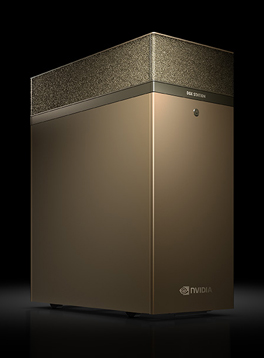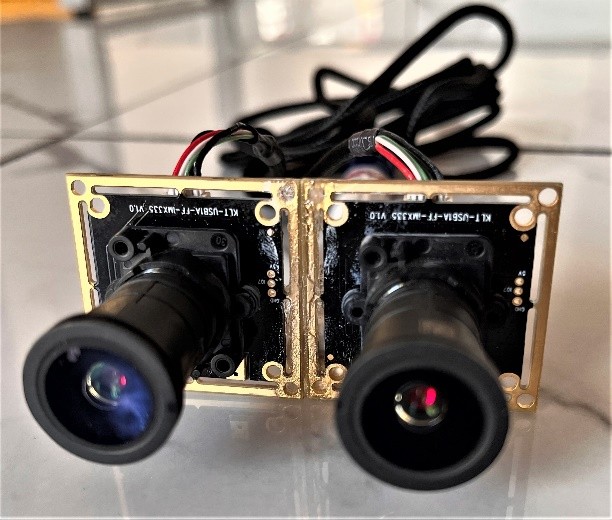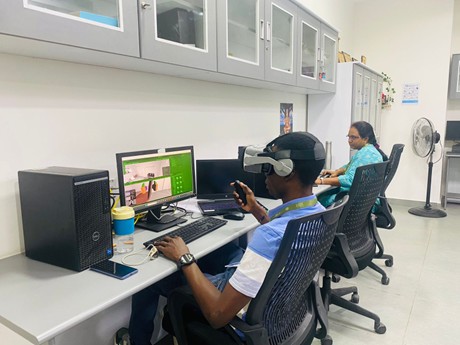The department houses several research and academic labs, each dedicated to a focused area of research. The lab members are faculty, students, research scholars, and dedicated staff. The labs have specialised software and computing facilities, and work on various projects within their field.
23
Academic Labs
6
Research Labs
1067
Systems

NVIDIA DGX-1
The NVIDIA DGX-1 is a deep learning system, architected for high throughput and high interconnect bandwidth to maximise neural network training performance. The core of the system is a complex of Eight Tesla V100 GPUs connected in the hybrid cube-mesh NVLink network topology.
NVLink is an energy-efficient, high-bandwidth interconnect that enables NVIDIA GPUs to connect to peer GPUs or other devices within a node at an aggregate bi-directional bandwidth of up to 300 GB/s per GPU: over nine times that of current PCIe Gen3 x16 interconnections. The NVLink interconnect and the DGX-1 architecture's hybrid cube-mesh GPU network topology enables the highest achievable data-exchange bandwidth between a groups of eight Tesla V100 GPUs.
The Algorithms and Complexity Theory lab focuses on developing advanced algorithms to analyse and optimise complex networks. The lab also works on identifying influential nodes and improving the information propagation model in graphs. To solve real-world problems in graph theory, hypergraphs, and data-driven applications, the team at the lab explores novel centrality measures, network structures, and computational techniques. In addition, the lab also works on implementing recommender systems using content-based, collaborative and hybrid techniques to analyse user-item interactions and scalable algorithms for large-scale complex networks.
System 1:
Processor: 13th Gen Intel® Core™ i9-13900 (2.00 GHz)
Cores: 24 cores (8 P-cores + 16 E-cores), 32 logical processors
RAM: 128 GB (128 GB usable)
Operating System: Windows 11 pro
Graphic card: T1000 8GB
Software: Anaconda, Origin
System 2:
Model: HP Z2 G8 Tower Workstation Desktop PC
Processor: 11th Gen Intel® Core™ i9-11900 (2.50 GHz, 2496 MHz)
Cores: 8 physical cores, 16 logical processors
RAM: 64 GB
Operating System: Microsoft Windows 11 Pro (10.0.26100 Build 26100)
Graphic card: NVIDIA GeForce RTX 3060 12GB
Software: Anaconda, Origin
System 3:
Model: MSI (Micro-Star International Co., Ltd.) MS-7D88
Processor: Intel® Core™ i9-14900K (3.20 GHz, 3200 MHz)
Cores: 24 physical cores, 32 logical processors
RAM: 64 GB
Operating System: Microsoft Windows 11 Pro (10.0.26100 Build 26100)
Graphic card: NVDIA 4060TI 8GB
Software: Anaconda, Origin
Processor: Intel Core™ i7-10700 CPU (2.90 GHz, 2904 MHz)
Cores: 8 physical cores, 16 logical processors
RAM: 16 GB
Operating System: Windows 11
Software: Anaconda, Origin
The Visual Information Processing Lab facilitates research and innovation in visual information processing by creating computational models and intelligent systems that can analyse, interpret, and comprehend visual data for various real-world applications. The lab currently works on developing state-of-the-art algorithms for image and video processing, computer vision, and pattern recognition, and developing low-power, real-time vision systems for edge computing. The lab applies research to medical imaging, remote sensing, industrial automation, and smart devices. The lab also extends its work into 3-D image modelling, deepfake image detection, and high-spectral image forensics analysis.
05 PC: intel(R) Core(TM) i5-10400 @ 2.90GHz 2.90 GHz, 16 GB RAM
04 PC: intel(R) Core(TM) i7-10700 CPU @ 2.90GHz 2.90 GHz, 16 GB RAM
01 PC: 12th Gen Intel(R) Core (TM) i7-12700 2.10 GHz, 32 GB RAM

The IoT and Cybersecurity Lab aims to create a secure and innovative research environment that addresses critical challenges in cybersecurity, with a particular focus on protecting IoT ecosystems from evolving cyber threats. A key objective of the lab is to equip researchers with expertise in cybersecurity practices, ethical hacking, secure IoT development, and advanced threat mitigation strategies. The lab’s research focuses on emerging technologies such as federated learning, blockchain, and virtual reality (VR), with a strong emphasis on cybersecurity. The lab also extends its work into healthcare applications, where cybersecurity is crucial in safeguarding patient data, medical devices, and immersive healthcare systems.
05 PC: intel(R) Core(TM) i5-10400 @ 2.90GHz 2.90 GHz, 16 GB RAM
04 PC: intel(R) Core(TM) i7-10700 CPU @ 2.90GHz 2.90 GHz, 16 GB RAM
01 PC: 12th Gen Intel(R) Core (TM) i7-12700 2.10 GHz, 32 GB RAM

The Nano Communication and Networking Lab explores various cutting-edge nanotechnologies and solutions. The lab conducts research on in vivo Wireless Nanosensor Networks for cardiac health monitoring, and designs nanoantennas for in vivo communications and networking at terahertz. It develops cross-layer MAC and Network layer solutions for in vivo information exchange between IoBNT and IoT. The research team in the lab also works on developing nano-sized biocompatible antennas operating in the terahertz band as a coupling device suitable for nanomachines for in vivo communications. The lab also extends to apply Machine Learning techniques to the prediction of deadly diseases in nano networks.
2 x i5 systems - DELL
3 x i7 systems – HP
Tyrone Workstation, CAMARERO-SS400TA-55

